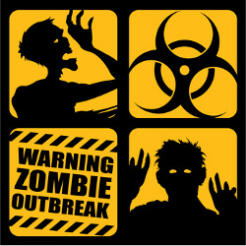Too many charities are languishing in the twilight zone between full health and insolvency, says Andy Rich.
You don’t need to be a fan of horror films to find the image compelling – an army of half-dead zombies roaming about aimlessly until someone puts them out of their misery.
This is the colourful picture painted by many economic commentators when describing Britain’s current business climate.
The zombies in question are the fatally weakened companies that are dead from the waist up, but being kept alive only by very low interest rates.
The term was coined to describe struggling companies, but there is growing evidence to suggest that many charities are in the same parlous state.
Below the radar
Quite how many zombie companies, or charities, there are is impossible to gauge. By definition they do not appear in the official statistics published quarterly by the Insolvency Service – as they exist in the twilight zone between full health and insolvency.
When the recession first hit in 2009, rates of insolvency rose sharply as thousands of businesses went to the wall.
But when insolvency rates began to fall soon afterwards, the economy continued to languish.
Since then the received wisdom has been that there are countless businesses that are just surviving – but which will inevitably fall off the cliff into insolvency when interest rates rise. It is widely seen as a question of when, not if, they tip over the edge.
Zombie charities – not dead, but not going anywhere
At first glance the picture appears similar for charities. It is true that some of the weaker charitable organisations are technically insolvent on an assets vs liability basis. The very weakest are limping on thanks to cashflow alone.
The one thing keeping the wolf from their door is the exceptional level of forbearance being shown by the banks. Many banks are cutting a lot of slack to charities over their debts.
This is allowing too many charities with a lack of funds and poor internal processes to stay afloat.
But it’s wrong to think of these zombie charities in the same way as zombie companies. Rather than being dead from the waist up, many of the afflicted charities are outwardly running as normal – albeit while treading water.
The trouble is they are neither able to move on from their past debts, nor are they being forced into bankruptcy.
But the limbo cannot last forever. While the new Governor of the Bank of England has hinted that interest rates are unlikely to increase from their current record low level any time soon, the banks’ patience with late-payers is finite.
Bad for them, worse for the economy
The prolonged agony of these zombie charities is inevitably stressful and unpleasant for their staff.
Though their supporters may not know it, there is a risk that their donations may be used to prop up the charity, rather than spent on its fundamental charitable purpose.
Seen in a wider context - these zombie charities risk failing in their charitable purpose and could even have a severe draining effect on the UK’s economic recovery.
It may sound brutal, but their limping on is holding back the economy as a whole.
Much better to allow the “terminal” zombies to go into insolvency. The insolvency process should enable their assets to be recycled, and eventually used more efficiently elsewhere.
No one doubts that these are tough times in which to run a successful charity. Most third sector organisations are facing uncertain income (making it almost impossible to plan ahead), erratic cash-flow, potential lack of structure, rising overhead costs and the realisation that some of them may lack the in-house skills needed to fund raise successfully.
However the future does not have to look so bleak. For charities that are not yet in the “terminal” zombie phase, there are often solutions to these potentially catastrophic problems.
Nipping problems in the bud
The most effective approach is to identify and neutralise potential problems before they become critical.The key for a struggling charity is to isolate the ‘pressure points’ that are most dangerous, and take corrective action.
In extreme cases where a charity cannot be saved, mergers could be the most logical option. The loss of independence, identity and possibly staff are hard to take – but if the charity’s mission continues, this may be a price worth paying.
Tough times can call for tough measures – but the key is to act decisively, and the earlier the better.
Andy Rich is a partner at HW Fisher and Company









